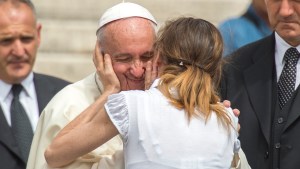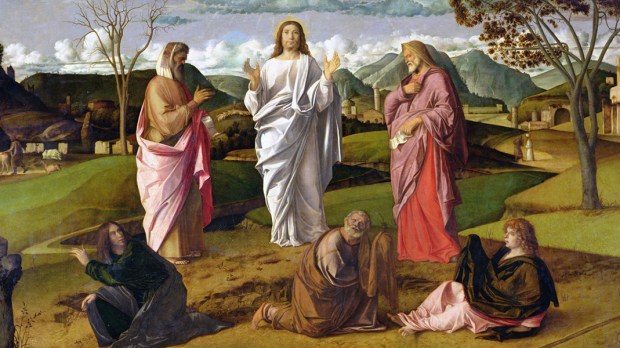August 6 is the Feast of the Transfiguration, the Gospel event in which Jesus is “transfigured” and becomes white as light. This Gospel account is also read during Lent.
Benedict XVI considered the meaning of this event in his book Jesus of Nazareth.
From his commentary, we can draw out seven symbols from the Transfiguration
1His three companions
Jesus took only three of his apostles with him for the Transfiguration: Peter, James and John. These are the same three who are close to Our Lord during the Agony in the Garden on the Mount of Olives, showing how these two scenes, while opposites, are “inextricably linked.” The Transfiguration leads to the Passion, and the Passion leads back to the glory of the Transfiguration.
At the same time, these three companions remind us of Exodus 24, “where Moses takes Aaron, Nadab, and Abihu with him as he climbs the mountain – though seventy of the elders of Israel are also included.”
2Mountaintop
Mountains have great significance in Scripture, often denoting the “locus of God’s particular closeness.”
For Jesus, the mountaintop is the site of various important events: “the mountain of the temptation; the mountain of his great preaching; the mountain of his prayer; the mountain of the transfiguration; the mountain of his agony; the mountain of the cross; and finally, the mountain of the risen Lord.”
The mountain is already highly symbolic in the Old Testament. There is Mt. Sinai, where the Commandments are given; Mt. Horeb (possibly another name for Sinai), as the site of the Burning Bush; and Mt. Moriah where Abraham was commanded to sacrifice Isaac.
“They are all at one and the same time mountains of passion and of revelation, and they also refer in turn to the Temple Mount, where revelation becomes liturgy,” Benedict says.
3Shining face
The transfiguration is a prayer event, Benedict explains. “It displays visibly what happens when Jesus talks with his father: the profound interpenetration of his being with God, which then becomes pure light.”
Jesus is “light from light” and this reality becomes perceptible to the senses.
“And he was transfigured before them,” Mark says quite simply, going on to add somewhat awkwardly, as if stammering before the mystery: “And his clothes became radiant, intensely white, as no one on Earth could bleach them.” (Mark 9:2-3)
Matthew has rather more elevated words at his command: “His face shone like the sun, and his clothes became white as light.” (Matthew 17:2)
Luke is the only one of the evangelists who begins his account by indicating the purpose of Jesus’s ascent: He “went up on the mountain to pray.” (Luke 9:28) It is in the context of Jesus’s prayer that he now explains the event that the three disciples are to witness: “And as he was praying, the appearance of his face was altered, and his clothing became dazzling white.” (Luke 9:29)
Our Lord’s radiant face shows the parallel with Moses in Exodus 34; Moses comes down from the mountain after having talked with God, with his face shining. However, Moses’ light comes from without, while Jesus’ light comes from within.
4Dazzling clothes
The evangelists also try to describe Jesus’ clothes, which also have become dazzling.
Benedict XVI says these garments speak of our own future. The Book of Revelation describes the saved as wearing white garments. They are white because they have been washed in the blood of the Lamb. “This means that through baptism they have been united with Jesus’s passion, and his passion is the purification that restores to us the original garment lost through our sin (cf. Luke 15:22). Through baptism we are clothed with Jesus in light and we ourselves become light.”
5Moses and Elijah
Moses, who received the Ten Commandments on stone tablets, represents the Law. Elijah represents the prophets.
Moses and Elijah are themselves figures of the passion and witnesses of the passion. They speak with the transfigured Jesus about what they said while on Earth, about the passion of Jesus. But by speaking of these things with Jesus during his transfiguration they make it apparent that this passion brings salvation; that it is filled with the glory of God; that the passion is transformed into light, into freedom and joy.
6The cloud
“And a cloud overshadowed them, and a voice came out of the cloud, ‘This is my beloved son; listen to him.’” (Mark 9:7) The holy cloud, the shekinah, is the sign of the presence of God himself.
This is the same image we have in the Old Testament, when the cloud over the Tent of Meeting indicated to the Israelites that God was present.
Now, Jesus is himself the holy tent, and the cloud of God’s presence enfolds others as well.
We saw the cloud at Jesus’ baptism, with the Father speaking from it: “You are my beloved son; with you I am well pleased.” (Mark 1:11)
7God's word
In contrast to the message from the cloud at the River Jordan, now on the mount of the Transfiguration, the Father says something more: “Listen to him.”
Here again we see the parallel with Sinai, and God’s revelation of his Word in the Commandments.
But here, notes Benedict, is something more:
H. Gese has provided a perceptive commentary on this scene: “Jesus himself has become the divine word of revelation. The Gospels could not illustrate it any more clearly or powerfully: Jesus himself is the Torah.” (Zur biblischen Theologie) This one command brings the theophany to its conclusion and sums up its deepest meaning. The disciples must accompany Jesus back down the mountain and learn ever anew to “listen to him.”

Read more:
You probably don’t think of the 10 Commandments like this! Check out the pope’s amazing insight

